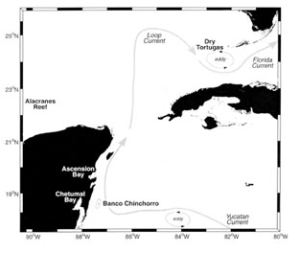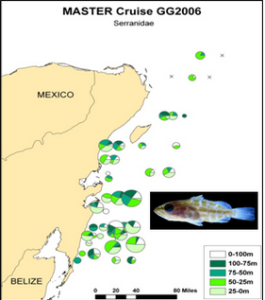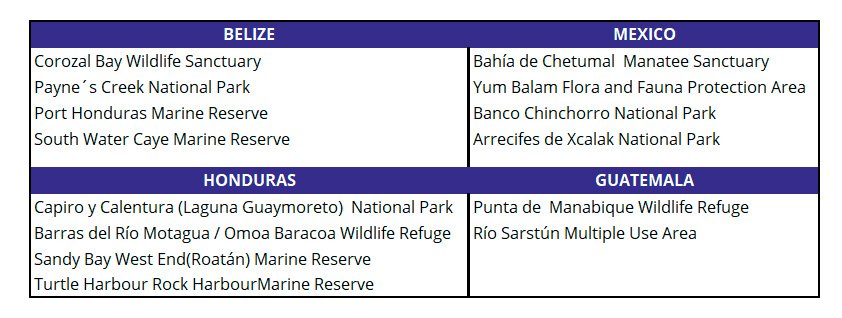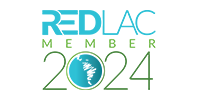

Introduction
Our team builds on successful academic and management partnerships that spans five-years between CONANP (Comisión Nacional de Áreas Naturales Protegidas), ECOSUR (El Colegio de la Frontera Sur), CINESTAV (Centro de Investigación y Estudios Avanzados), NOAA Early Life History Unit at SEFSC, NOAA Physical Oceanography Department at AOML, and the University of Miami-RSMAS (Rosenstiel School of Marine and Atmospheric Science). As a result of this interdisciplinary work, we are obtaining preliminary research and management results including assessments of larval reef fish biodiversity, distribution and relevant coastal oceanographic dynamics.
This includes fishes that are ecologically and socioeconomically important to the Mesoamerican reef system such as snappers, groupers, parrotfishes and hogfishes. Two broad questions drive this research:
- What is the level of larval dispersal and recruitment connectivity within and amongst the Mesoamerican reef, the Dry Tortugas, and the Florida Keys National Marine Sanctuary’s reserves?
- Is there evidence of self-recruitment within these marine reserves? Reef fish populations are part of one of the most complex ecosystems in the marine environment.
They are also the most heavily exploited part of the ecosystem and have been pushed to extremely low levels throughout the wider Caribbean. Despite the importance of these populations, relatively little is known about most stages of their life cycles or their interaction with small and mesoscale oceanographic patterns. Important information such as adult spawning behavior, location, and depth of spawning aggregations and recruitment is mostly unknown. Little is known about the status of these fish populations in the western Caribbean along the Meso-American reef system, though stocks there are generally considered to have suffered relatively less exploitation.
There are also significant gaps in our understanding of the complex circulation patterns along the western Caribbean’s Yucatan coast where the Caribbean Current and the Loop Current connect and flow into the Gulf of Mexico (Figure). This area plays a potentially important but still unknown role in the route of subtropical gyre circulation which drives the biological production and transport of larvae throughout this region. This research project was designed to provide a baseline study of the fisheries oceanography of the western Caribbean during winter spawning and to provide a basis for future fisheries management decisions.

In addition to multiple inshore surveys that targeted nursery habitats for juvenile and newly settled fishes, shipboard oceanographic surveys were also conducted to establish a baseline of ichthyoplankton abundance and distribution regionally along the reef. Some of the goals and results of this collaborative project include, 1) data applied directly to developing and updating local and regional management plans, and 2) technology/training transfer for future capacity-building in the local communities and academic institutions, and 3) tools and deliverables for local governmental agencies, resource managers, and stakeholders.
The figures below depict sampling locations in relation to MPAs and preliminary results from our fisheries-oceanography cruise in 2006. Grouper (Serranidae) abundance is shown per station at different depths. Also attached is the map with the 14 initial priority MPAs for the MAR Fund.


Because the MAR region has at least 63 coastal and marine protected areas that are part of the national MPA systems of the four countries, the decision to work with a smaller number of areas to integrate the initial network was made. The idea is to begin with a smaller group of priority conservation areas and to incorporate additional groups of areas progressively. To select the priority areas, MAR Fund facilitated a process that included the participation of different actors from the four countries. The methodology that was designed for this purpose was applied initially through four workshops to obtain the national priorities. These results were then analyzed at a regional workshop, in which the number one priorities for the region were defined.
The initial network of 14 areas includes the sites indicated in Table.

MPA Capacity-Building and Mesoamerican Reef Connectivity Workshop For further information on connectivity in the MAR, please visit these links:.


First Regional Connectivity Workshop
Metas y Resultados Samantha Whitcraft & Estrella Malca / NOAA
Mejorar la capacidad regional mediante la creación de una Coalición de Conectividad SAM de administradores y científicos; proveer un mecanismo y un calendario para las comunicaciones/colaboraciones entre los administradores, ECOSUR, Fondo SAM y NOAA-CIMAS-RSMAS.
Larval Reef Fish Research Lourdes Vásquez / ECOSUR
Larval Reef Fish Research Lourdes Vásquez / ECOSUR.
Larval reef fish and fisheries oceanography research, Mesoamerican Reef – Overview Samantha Whitcraft & Estrella Malca / NOAA
Larval reef fish and fisheries oceanography research, Mesoamerican Reef – Overview Samantha Whitcraft & Estrella Malca / NOAA
Case Study: Fisheries Oceanography in the USVI; management implications & applications Trika Gerard / NOAA
Case Study: Fisheries Oceanography in the USVI; management implications & applications Trika Gerard / NOAA
Área de Protección de Flora y Fauna Yum Balam Rafael de la Parra /CONANP
Área de Protección de Flora y Fauna Yum Balam Rafael de la Parra /CONANP
Parque Nacional Isla Contoy Dr. Jaime González / CONANP
Parque Nacional Isla Contoy Dr. Jaime González / CONANP
Parque Nacional Arrecifes de Cozumel Ricardo Gómez Lozano / CONANP
Parque Nacional Arrecifes de Cozumel Ricardo Gómez Lozano / CONANP
Reserva de Biosfera Banco Chinchorro / Parque Nacional Arrecifes de Xcalak María del Carmen García Rivas / CONANP
Reserva de Biosfera Banco Chinchorro / Parque Nacional Arrecifes de Xcalak María del Carmen García Rivas / CONANP
Corozal Bay Wildlife Sanctuary Zoe Walker / SACD
Corozal Bay Wildlife Sanctuary Zoe Walker / SACD
Southwater Caye Marine Reserve Juan Chub / Belize Fisheries Department
Southwater Caye Marine Reserve Juan Chub / Belize Fisheries Department
Port Honduras Marine Reserve Marlon Williams / TIDE
Port Honduras Marine Reserve Marlon Williams / TIDE
Refugio de Vida Silvestre Punta de Manabique Edelweiss Hildebrand / Fundación Mario Dary
Desarrollar un sistema de manejo integrado del ecosistema marino-costero de Punta de Manabique, que permita el mantenimiento de sus procesos ecológicos esenciales y la sostenibilidad en la producción de bienes y servicios derivados: manejo forestal, caza, pesca, tránsito, turismo y desarrollo comunitario.
Roatan Marine Park Jenny Myton / Roatán Marine Park
Roatan Marine Park Jenny Myton / Roatán Marine Park
Comunidad y Bidoversidad A.C. Constanza Ribot
Comunidad y Bidoversidad A.C. Constanza Ribot
Agenda
Este es un taler para promover una mayor comprensión de la conectividad biofísica a lo largo del Sistema Arecifal Mesoamericano (SAM) y su rol potencial en la gestión a escala de ecosistemas de las áreas protegidas a través del intercambio de experiencias e ideas entre la administración y el personal científico para identifcar metas convergentes/comunes a largo plazo (ver documentación de apoyo adjunta:
- Mapas de oceanografía para pesquerías de NOA-ELH/ECOSUR y
- Mapa de AMPs prioritarias del Fondo SAM).
Press Release
Más de 40 expertos de México, Belice, Honduras, Guatemala y Estados Unidos se reunieron del 17 al 19 de mayo del presente en el “Taller de Capacitación Regional sobre Áreas Marinas Protegidas: Conectividad en el Arecife Mesoamericano” celebrado en el Colegio de la Frontera Sur (ECOSUR) unidad Chetumal.

Second Regional Connectivity Workshop
Second Regional Connectivity Workshop
2nd Regional WORKSHOP: MPA Capacity-Building and Mesoamerican Reef Connectivity
Participants: regional natural resource managers, staff and stakeholders that work with/in the prioritized MAR MPAs.
Purpose: This is the 2nd Regional workshop to promote a better understanding of the bio-physical connectivity along the Mesoamerican reef (MAR) and its potential role in ecosystem-scale management of associated protected areas. This workshop is intended to be a practical, hands-on approach in connectivity research and data acquisition.
Where:
Day 1: El Colegio de la Frontera Sur (ECOSUR), Chetumal, Quintana Roo, Mexico.
Day 2: Parque Nacional Arrecifes de Xcalak, Quintana Roo, Mexico. When: March 13 -14, 2012
Goals:
The workshop goals are a result of the three priorities established by local managers in the 2010 workshop held in ECOSUR, Chetumal, Q. Roo:
- Workshop goal: provide hands-on training by experts and exchange experiences in connectivity research in the Mesoamerican region in recruitment, invasive species (lionfish) and transport patterns.
- Management goal: support capacity building in the MAR region by training of local managers and the “training of trainers” in connectivity issues and invasive species (lionfish) with parallel protocols.
- Connectivity Research goal: to obtain comparable baseline information on a regional basis, our goal is to carry out at least one simultaneous network-wide activity utilizing the training acquired in this workshop, by combining the biological and oceanographic components in the network of MPAs (at least one MPA per country).
During the workshop, a proposal will be developed by participants (managers, NGOs and academic partners) that they can coordinate, execute and analyze, with the following components:
- simultaneous collections of recruitment (fish) using settlement traps and
- combination of the biological data with continuous sea temperature measurements by deployment of data loggers.
Agenda
Day 1
9:00 – 9:15 Welcome & Introduction: workshop goals and expected results (ECOSUR/NOAA-UM/MAR Fund)
9:15 – 10:30 Mesoamerica reef connectivity research & regional updates from MPA representatives (Government, academic or NGOs): overview presentations by members of the Network on research, management and connectivity related work in the region. (Each presentation will have 15 minutes).
10:30 – 10:45 Coffee break
10:45 – 13:00 Cont. Mesoamerica reef connectivity research & regional updates from MPA representatives (Government, academic or NGOs): overview presentations by members of the Network on research, management and connectivity related work in the region. (Each presentation will have 15 minutes).
13:00 – 14:00 Lunch
14:00 – 16:30 Parallel Sessions
14:00 – 15:15
Group 1
Demonstrative deployment of biological gear, microscope activities, how to prepare the database of larval observations. Led by Lourdes Vasquez-Yeomans and Estrella Malca.
Group 2
Introduction to data formats and instrumentation deployment (programming) using the web developed database for the MRS connectivity group. Examples: oceanographic equipment, experimental set up and deployment. Led by Laura Carrillo, PhD. 15:15 – 16:30 Group 2. Demonstrative deployment of biological gear, microscope activities, how to prepare the database of larval observations. Led by Lourdes Vasquez-Yeomans and Estrella Malca. Group 1. Introduction to data formats and instrumentation deployment (programming) using the web developed database for the MAR connectivity group. Examples: oceanographic equipment, experimental set up and deployment. Led by Laura Carrillo, PhD.
16:30 – 16:45 Coffee break
16:45 – 17:45 Invasive species in the Mesoamerican Reef:Lionfish module, Part 1. Led by Eloy Sosa with collaboration from R. Gomez (CONANP)
16:45 – 17:15 Introduction (E. Sosa) – 30 mins
17:15 – 17:45 Overview of actions against lionfish (R. Gómez) – 30 mins
Day 2
06:00 – 7:30 Transportation to Xcalak, a fishing village within the Parque Nacional Arrecifes de Xcalak (PNAX). Breakfast will be inside the bus, during the trip.
7:30 – 9:00 Field activity to collect deployed gear (biological and oceanographic). This includes: Activities on juvenile/larval fish recruitment: biological collecting, equipment set up and discussion. Led by Lourdes Vasquez-Yeomans and Estrella Malca. Field activity on coastal oceanography: oceanographic equipment, experimental set up and deployment. Led by Laura Carrillo, PhD.
9:00 – 10:00 Lionfish collection. Activity coordinated by PNAX staff (J. Gómez).
10:00 – 10:20 Coffee break
10:20 – 12:30 Invasive species in the Mesoamerican Reef:Lionfish module, Part 2. Led by Eloy Sosa, R- Gomez (CONANP), N. Hernandez (PNAC), J. Gómez (PNAX), E. Caamal (PNIC) and O. Alvarez (CONANP)
10:20 – 10:40 Measuring key data on lionfish abundance (N. Hernández & E. Sosa) – 20 min
10:40 – 10:55 Methods for evaluating abundance (E. Sosa & E. Caamal) – 15 min
10:55 – 11:10 Fisher participation in control programs, Puerto Morelos case-study (O. Alvarez) – 15 min
11:10- 11:25 Public participation in control programs, Xcalak case-study (J. Gómez) -15 min
11:25 – 12:00 Discussion and concluding remarks (R. Gómez and E. Sosa). 35 min
12:00 -13:00 Lunch
13:00-14:30 Data analysis of collections/ sample analysis
13:00 – 13:45 Biological data – 45 min
13:45 – 14:30 Oceanographic data – 45 min
14:30 – 16:30 Project development by participants led by workshop organizers Coordinate and establish objectives, tasks, time frame, expected results, end date, communication protocol for simultaneous deployment of the Connectivity Network in the MAR region.
16:30 – 16:45 Coffee break
16:45 – 17:30 Workshop wrap up & conclusions (Summaries and lessons learned/discussions)
17:30 – 19:00 Transportation to Chetumal

Documents
Pesca Marina
Sosa-Cordero, E. y Angélica Ramírez González. 2011. Pesca Marina. p. 183-189. In: C. Pozo, N. Armijo y S. Calmé. (Eds.). C. Pozo, N. Armijo Canto y S. Calmé. (Eds.). Riqueza Biológica de Quintana Roo. Un análisis para su conservación. Tomo I. El Colegio de la Frontera Sur (ECOSUR)-Comisión Nacional para el Conocimiento de la Biodiversidad (CONABIO)-Gobierno del Estado de Quintana Roo-Programa de Pequeñas Donacionaes-PNUD.
La pesquería de langosta Panulirus argus es una actividad de relevancia ecológica, social y económica en las costas de Quintana Roo
Sosa-Cordero, E. 2011. La langosta, pesquería emblemática de Quintana Roo. p. 221-227. In: C. Pozo, N. Armijo Canto y S. Calmé. (Eds.). Riqueza Biológica de Quintana Roo. Un análisis para su conservación. Tomo I. El Colegio de la Frontera Sur (ECOSUR)-Comisión Nacional para el Conocimiento de la Biodiversidad (CONABIO)-Gobierno del Estado de Quintana Roo-Programa de Pequeñas Donacionaes-PNUD.
Parque Nacional Isla Contoy – Verano 2010
Trabajo de campo / Field Work y laboratorio. Colectamos datos oceanograficos (temperatura, salinidad, corrientes, etc) conjunto con colectas de larvas y juveniles de peces en el Parque Nacional Isla Contoy en Agosto 2010. Este trabajo es producto de la colaboracion de NOAA, ECOSUR, CONANP
Connectivity Workshop 2010
This handbook is a product of the Coral Reef Targeted Research & Capacity Building for Management Program (CRTR)
Preserving Reef Connectivity: A Handbook for Marine Protected Area Managers aims to help managers of coastal areas, in particular those of coastal marine protected areas (MPAs), understand and apply the concept of connectivity work. By Dr. Peter Sale among others.




